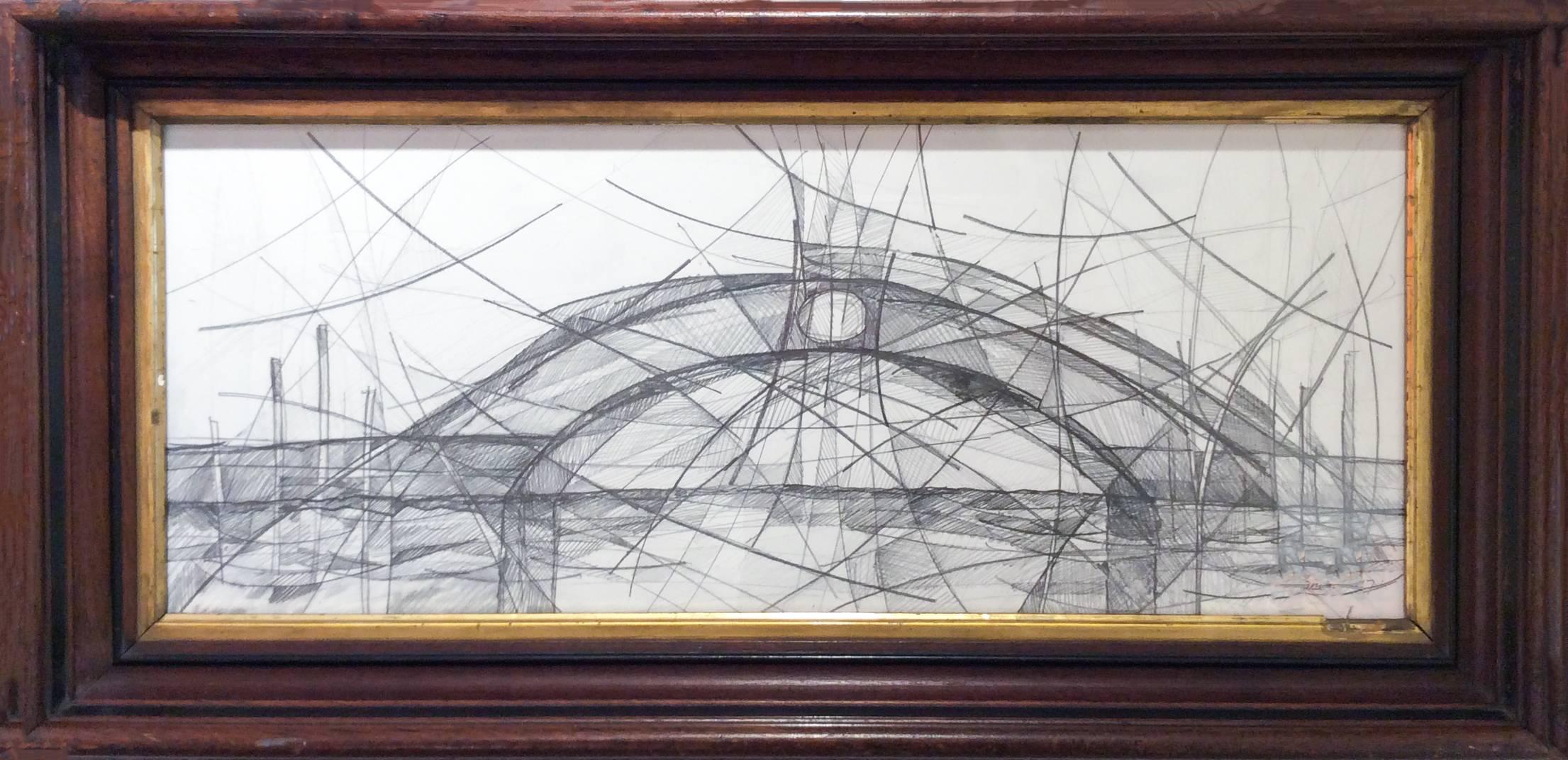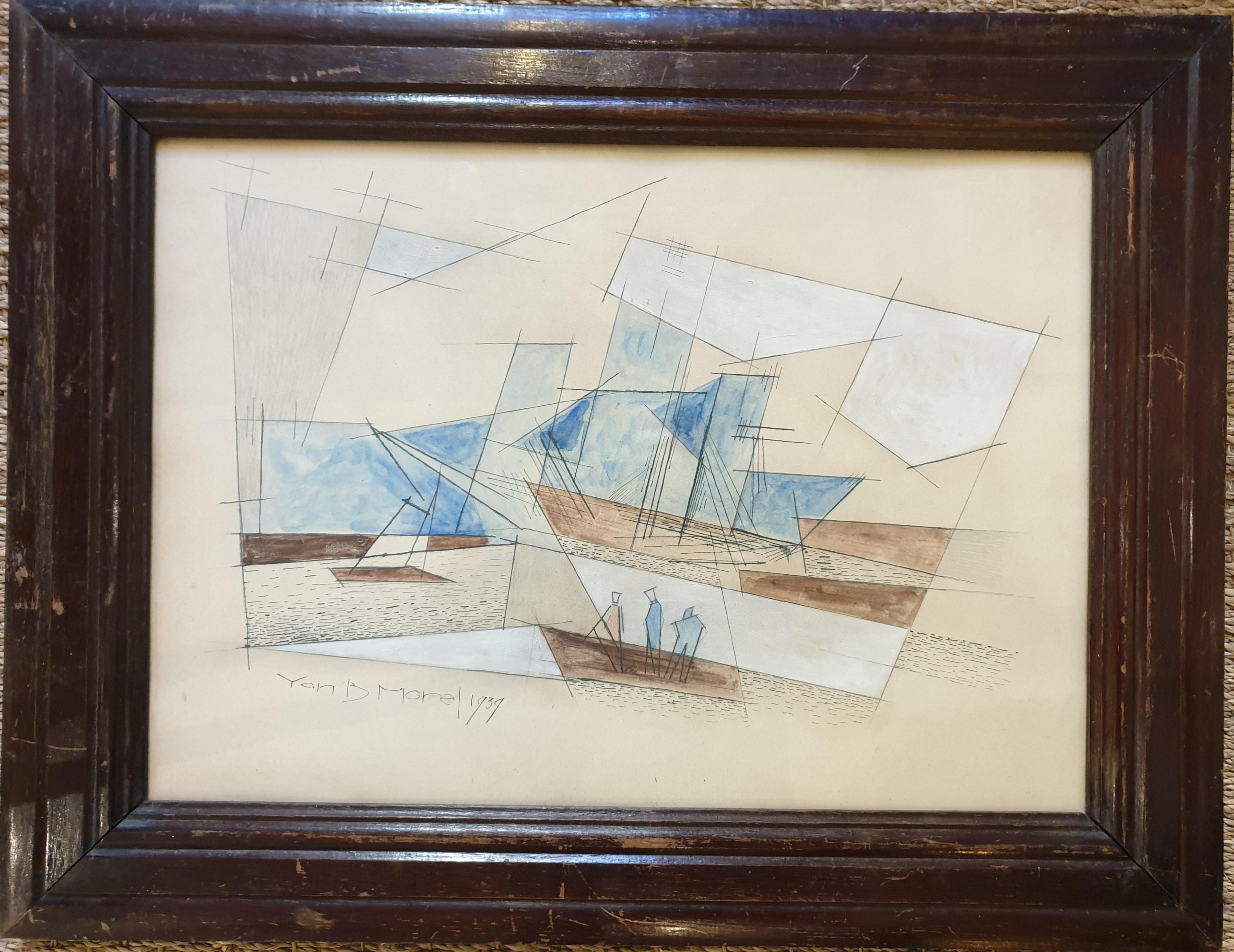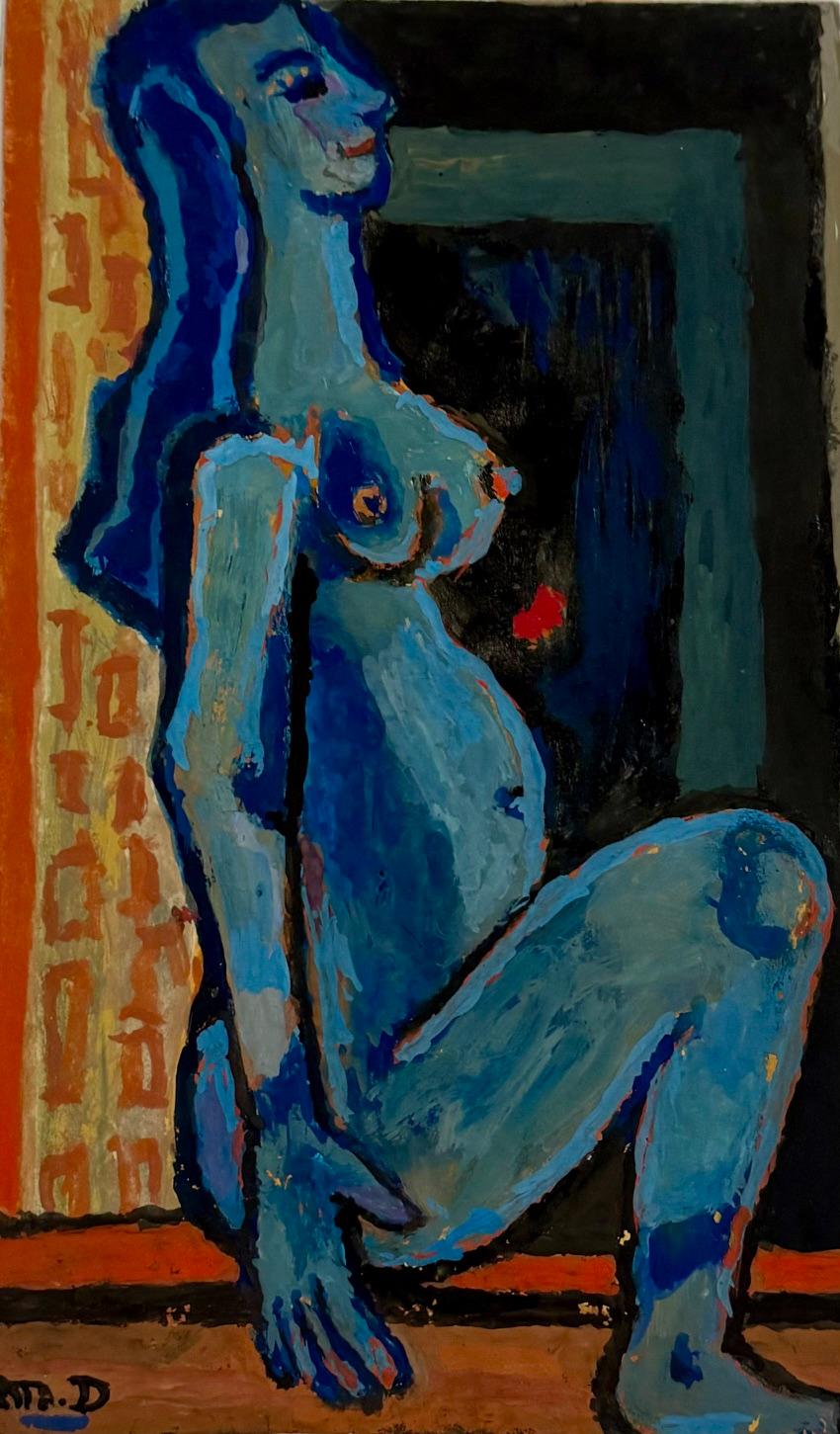Items Similar to A Graphite on Paper Mural Study of a Rail Yard by Rudolph Weisenborn, ca. 1940
Want more images or videos?
Request additional images or videos from the seller
1 of 5
Rudolph WeisenbornA Graphite on Paper Mural Study of a Rail Yard by Rudolph Weisenborn, ca. 1940ca. 1940
ca. 1940
About the Item
A graphite on paper, untitled mural study, Cubist scene of a rail yard by WPA-era artist Rudolph Weisenborn, ca. 1940. Archivally matted to 16" x 18". Provenance: Estate of the artist.
Rudolph Weisenborn was born in Strassburg, Germany in 1881, but was orphaned at the age of nine. He was taken-in by Mid-Western farmer Thomas Westaby and spent his early years in Wisconsin, Iowa and North Dakota. Weisenborn first attended the University of North Dakota in 1898, then the Students School of Art in Denver. Various accounts have him working out west as a gold miner and cowboy.
Around 1912, he settled in Chicago and worked as a window designer for Marshall Field’s. Weisenborn is best known as the founder of the Chicago No-Jury Society of Artists. The group was founded because many artists could not get their work accepted into the mainstream Art Institute shows. Weisenborn is quoted as saying that he harbored feelings of disdain for any jury and that his own paintings were frequently rejected by conservative jurors. He was also involved and helped found other radical artist’s groups such as the Salon des Refuses, Cor Ardens and Neo-Arlimusic. In 1936, he helped found the New York-based American Abstract Artist’s Group. He created the only abstract mural for the 1933 Century of Progress Exhibition in Chicago and also worked for the Federal Arts Project in the Easel Division. His WPA murals can be found in Crane Technical High School and Nettlehorst Elementary School in Chicago, IL. In 1945, Chicago businessman Herman Spertus commissioned Weisenborn to paint the mural “The Fighting Navy” for the Great Lakes Naval Training Station. He taught at Hull House (1920), the Chicago Academy of Fine Arts (1922-34), his own Weisenborn Art School (1934-64), and the Austin, Oak Park, River Forest Art League in Oak Park (1941). Weisenborn died in Chicago in 1974.
- Creator:Rudolph Weisenborn (1881-1974, American)
- Creation Year:ca. 1940
- Dimensions:Height: 11.75 in (29.85 cm)Width: 9.75 in (24.77 cm)
- More Editions & Sizes:Matted to 18" x 16"Price: $850
- Medium:
- Movement & Style:
- Period:
- Condition:See Photos.
- Gallery Location:Chicago, IL
- Reference Number:
About the Seller
No Reviews Yet
Vetted Seller
These experienced sellers undergo a comprehensive evaluation by our team of in-house experts.
Established in 2000
1stDibs seller since 2023
9 sales on 1stDibs
Typical response time: <1 hour
- ShippingRetrieving quote...Ships From: Chicago, IL
- Return PolicyThis item cannot be returned.
More From This SellerView All
- A Cubist, Untitled Mural Study of a City Scene by Artist Rudolph WeisenbornBy Rudolph WeisenbornLocated in Chicago, ILA graphite on paper, untitled mural study, Cubist city scene by WPA-era artist Rudolph Weisenborn, ca. 1940. Archivally matted to 16" x 18". Provenance: Estate of the artist. Rudolph Weisenborn was born in Strassburg, Germany in 1881, but was orphaned at the age of nine. He was taken-in by Mid-Western farmer Thomas Westaby and spent his early years in Wisconsin, Iowa and North Dakota. Weisenborn first attended the University of North Dakota in 1898, then the Students School of Art in Denver. Various accounts have him working out west as a gold miner and cowboy. Around 1912, he settled in Chicago and worked as a window designer for Marshall Field’s. Weisenborn is best known as the founder of the Chicago No-Jury Society of Artists. The group was founded because many artists could not get their work accepted into the mainstream Art Institute shows. Weisenborn is quoted as saying that he harbored feelings of disdain for any jury and that his own paintings were frequently rejected by conservative jurors. He was also involved and helped found other radical artist’s groups such as the Salon des Refuses, Cor Ardens and Neo-Arlimusic. In 1936, he helped found the New York-based American Abstract Artist’s Group. He created the only abstract mural for the 1933 Century of Progress Exhibition in Chicago and also worked for the Federal Arts Project in the Easel Division. His WPA murals can be found in Crane Technical High School and Nettlehorst Elementary School in Chicago, IL. In 1945, Chicago businessman Herman Spertus...Category
1940s Cubist Abstract Drawings and Watercolors
MaterialsPaper, Charcoal
- Textile DesignBy Andre DelfauLocated in Chicago, ILA colorful textile design in orange, blue, red and yellow tones depicting an abstract polychrome Wedge Star pattern by set and costume designer Andre Delfau.Category
1950s American Modern Abstract Drawings and Watercolors
MaterialsInk, Gouache, Graphite
- Textile DesignBy Andre DelfauLocated in Chicago, ILA colorful textile design (with blue, green, yellow & red tones) by notable set and costume designer Andre Delfau. Born in Paris, France in 1914, Andre Delfau became an internationally acclaimed stage, set and costume designer who worked world-wide from the 1930s to the 1980s. Delfau was a life long artist and painted independently of his noted design career. His artwork is recognized for it’s vibrant color and form, and a particularly keen use of line. He was highly influenced by the French Modern trends of Cubism and Surrealism, and his artwork is often infused with a dramatic sense of architecture and perspective. Delfau created fashion designs for such major Paris couture houses as Balmain, Jean Patou and Balenciaga. He completed noteworthy set designs and costumes for numerous international operatic and ballet productions, including those at the Royal Danish Ballet, the Royal Ballet of Great Britain, the Paris Opera, the Dance Theater of Harlem, the Ruth Page International Ballet, the Civic Ballet of Chicago, the Chicago Opera Ballet and the Lyric Opera of Chicago, among others. Most notably, Delfau designed the elaborate stage sets and costumes for the 1986 PBS television production of the Viennese operetta, "Die Fledermaus...Category
1950s American Modern Abstract Drawings and Watercolors
MaterialsInk, Gouache, Graphite
- Textile DesignBy Andre DelfauLocated in Chicago, ILA colorful 1950s textile design (Black, yellow, blue, pink, red tones) by noted set and costume designer Andre Delfau. Born in Paris, France in 1914, Andre Delfau became an internationally acclaimed stage, set and costume designer who worked world-wide from the 1930s to the 1980s. Delfau was a life long artist and painted independently of his noted design career. His artwork is recognized for it’s vibrant color and form, and a particularly keen use of line. He was highly influenced by the French Modern trends of Cubism and Surrealism, and his artwork is often infused with a dramatic sense of architecture and perspective. Delfau created fashion designs for such major Paris couture houses as Balmain, Jean Patou and Balenciaga. He completed noteworthy set designs and costumes for numerous international operatic and ballet productions, including those at the Royal Danish Ballet, the Royal Ballet of Great Britain, the Paris Opera, the Dance Theater of Harlem, the Ruth Page International Ballet, the Civic Ballet of Chicago, the Chicago Opera Ballet and the Lyric Opera of Chicago, among others. Most notably, Delfau designed the elaborate stage sets and costumes for the 1986 PBS television production of the Viennese operetta, "Die Fledermaus...Category
1950s American Modern Abstract Drawings and Watercolors
MaterialsInk, Gouache, Graphite
- Textile DesignBy Andre DelfauLocated in Chicago, ILA bright, geometric textile design (In red, white & blue) by stage and costume designer Andre Delfau.Category
1950s American Modern Abstract Drawings and Watercolors
MaterialsInk, Gouache, Graphite
- Textile DesignBy Andre DelfauLocated in Chicago, ILA textile design in black and brown ochre tones with wedge star pattern by noted set and costume designer Andre Delfau.Category
1950s American Modern Abstract Drawings and Watercolors
MaterialsInk, Gouache, Graphite
You May Also Like
- Venetian Bridge X (Abstract, Cubist Style Graphite Drawing in Vintage Frame)By David Dew BrunerLocated in Hudson, NYgraphite on paper in vintage wood frame with gold detail 8 x 20.5 inches unframed 12 x 24.5 x 2 inches framed This contemporary, horizontal, black & white graphite work on paper w...Category
2010s Cubist Abstract Drawings and Watercolors
MaterialsPaper, Graphite
- Late Art Deco Period Cubist Nautical Harbour SceneLocated in Cotignac, FRLate Art Deco Period, Cubist watercolour of a nautical harbour scene painted by Yan Bernard Morel (dit Yan Bernard Dyl ) in 1939. Yan B. Morel, born on June 18th 1887, was a French painter, landscape designer, decorator, illustrator and film maker. Morel was a friend of Robert Delauney...Category
1930s Cubist Abstract Drawings and Watercolors
MaterialsPaper, Watercolor, Carbon Pencil
- Three Cubist Still Life Studies by Philadelphia Artist and Collector Earl HorterBy Earl HorterLocated in Philadelphia, PAEarl Horter (American, 1883-1940) Three Still Life Studies Pencil on paper, 7 1/4 x 13 1/2 inches; Framed: 17 x 21 inches NOTE: while originally mounted with archival materials, the...Category
Early 20th Century Cubist Abstract Drawings and Watercolors
MaterialsPaper, Pencil
- The Balcony (Drawing for Plate I, Planches de Salut)By Louis MarcoussisLocated in London, GBLOUIS MARCOUSSIS (1883-1941) (Ludwik Kazimierz Wladyslaw Markus) 1878 or 1883 Łódź, Poland – 1941, Cusset, France (Polish/French) Title: The Balcony (Drawing for Plate I, Plan...Category
1930s Cubist Abstract Drawings and Watercolors
MaterialsPencil
- Nude StudyBy Federico CastellonLocated in Wilton Manors, FLdouble-sided c.1950's drawing by Spanish artist, Federico Castellon (1914-1971). Ink on wove paper, sheet measures 10 x 13 inches; 21.5 x 24.5 inches in wood frame. Excellent condition with no restoration or damage. Signed with artist's chop in red ink seal that he used in Asia. From a recently discovered collection of over 60 important Castellon drawings and watercolors c.1939-1950. Birth place: Almeria, SpainDeath place: New York, NYAddresses: NYC (immigrated 1921; citizen, 1943)Profession: Painter, graphic artist, sculptor, etcher, illustrator, teacher Exhibited: Weyhe Gal., 1934, 1936-40; AIC, 1935-47 (prize, 1938); AFA traveling exh., 1937; WMAA, 1938-45; PAFA, 1938-39, 1940 (prize), 1941-42; Carnegie Inst., 1942; PAFA, 1943-53; Assoc. Am. Ar., 1946 (prize), 1952 (solo); Corcoran Gal, 1947; LOC, 1949 (prize); Paris, France, 1952; Bombay, India, 1952; Gallery 10, 1961; Dintenfass Gal., N.Y., 1963; Phila. Pr. Cl., 1964 (prize); Hudson Gld. A., 1964; Great Neck, L.I., 1964; SAGA, 1964 (prize). In 1953, under the auspices of State Dept. Specialist Div., of I.E.S., he exhibited in Venezuela, Colombia, Peru, Chile, Bolivia, Uruguay, Argentina, Paraguay, with lectures in each country. Awards: F., Spanish Republic, 1934-36; fellow, Guggenheim Fnd., 1941, 1950; Nat. Inst. A. & Let. Grant, 1950. Member: NA; SAGAWork: WMAA; PAFA; MoMA; PMA; MMA; BM; AIC; NYPL; LOC; Univ. KY; San Diego Mus. FA; Newark (NJ) Pub. Lib.; Princeton Univ. (Frank Jewett Mather Coll.). Comments: A Surrealist painter whose imagery of the 1930s was greatly influenced by Dali. His full name was Federico Cristencia de Castellón y Martinez. Teacher: Columbia Univ., 1946-61; Pratt Inst., Brooklyn, 1952-61. Illustrator: Shenandoah, 1941; I Went into the Country, 1941; Bulfinch's Mythology, 1948; The Story of Marco Polo, 1954; The Man Who Changed China, 1954; The Story of J. J. Audubon, 1955; The Little Prince, 1954; The Life of Robert L. Stevenson, 1954. Reproduction of paintings on The Sumerian Civilization" for Life series "The Epic of Man," 1956; 15 paintings on "The History of Medicine" for MD magazine, 1960-61; The Story of Madame Curie...Category
Mid-20th Century Cubist Nude Drawings and Watercolors
MaterialsPaper, Ink
- Blue Figure Sitting by Michel Debieve Mid-Century French Cubist PaintingLocated in Atlanta, GAMichel Debiève was born on May 29, 1931, with his twin brother Raymond, in a popular suburb of Maubeuge (North of France). Very early, encouraged by Emile, their father, the two brot...Category
Mid-20th Century Cubist Figurative Paintings
MaterialsPaper, Mixed Media
Recently Viewed
View AllMore Ways To Browse
1940 German Military
G Schneider
Tokyo Dealer
Oil Late 1800s
Good Night Cover
Richard Small Mirror
Exhibition Poster Mexico
Kenneth Brown Design
Fishing New England
African Dog
American Painting 1830
She Wall Shelf
Calder 1969 Signed
New Zealand Themed Art
Print Of Heron Bird
Ballet Black And White Drawing
Woman Size 48 New
Israeli Judaica Art Oil Paintings





